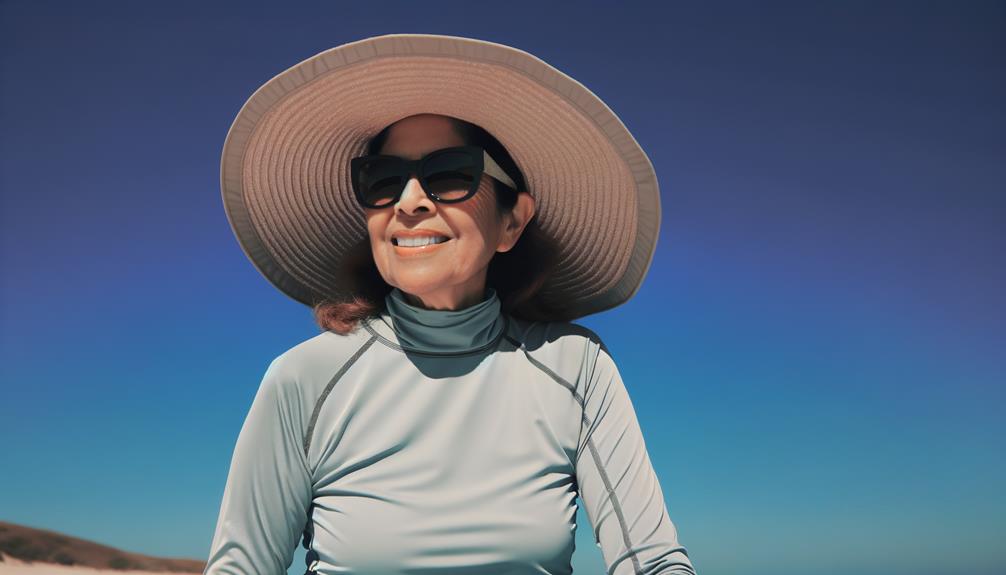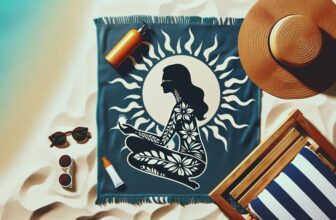As we embrace the allure of sunny days, it's imperative to acknowledge the potential consequences of prolonged sun exposure on our skin. The quest for maintaining an even skin tone and preventing darkening necessitates a deeper understanding of effective sun protection strategies.
In this discussion, we will explore practical and scientifically-backed measures to shield the skin from the sun's harmful rays. From dietary considerations to the strategic use of sun-protective clothing, this comprehensive guide aims to equip you with the knowledge and tools to proactively defend your skin against darkening.
So, let's unravel the secrets to achieving a luminous complexion while navigating the sunny outdoors.
Key Takeaways
- Apply sunscreen with a broad-spectrum SPF of at least 30 and reapply after swimming or sweating.
- Seek shade during peak sun hours and wear sun-protective clothing, including wide-brimmed hats and long-sleeve shirts.
- Eat a diet rich in antioxidants, vitamin C, and vitamin E to help prevent skin darkening.
- Understand the UV index and timing to take appropriate precautions and protect your skin from sun damage.
Sun Protection Measures

When aiming to protect your skin from the sun, it is essential to implement effective sun protection measures. Sun exposure can lead to skin darkening, particularly for individuals with darker skin tones. Sunblock and sunscreen are vital in preventing skin darkening.
Sunblock, often physical blockers, works by reflecting or scattering the sun's rays. Meanwhile, sunscreen, which contains chemicals that absorb UV radiation, also prevents you from getting darker by reducing the amount of UV light that penetrates the skin.
Sun damage on black skin can lead to hyperpigmentation and an increased risk of skin cancer, making dark skin sun protection crucial. Avoid the sun during peak hours, typically between 10 am and 4 pm, when the sun's rays are the strongest. Seek shade under umbrellas, trees, or buildings, and wear sun-protective clothing like wide-brimmed hats and long-sleeve shirts.
Using broad-spectrum sunscreen with a sun protection factor (SPF) of at least 30 is essential. By taking these precautions, you can effectively prevent sun-induced skin darkening and reduce the risk of sun damage.
Diet for Skin Darkening Prevention
Consuming a diet rich in antioxidants and essential nutrients can play a crucial role in preventing skin darkening caused by sun exposure. Antioxidants like vitamin C, vitamin E, and omega-3 fatty acids help protect the skin from UV damage and reduce the risk of getting darker in the sun. Foods high in antioxidants include berries, citrus fruits, bell peppers, nuts, seeds, and lycopene-rich foods like tomatoes.
Additionally, staying hydrated by drinking plenty of water is important for maintaining healthy skin and preventing darkening in the sun. It's also essential to limit the consumption of processed and sugary foods, as they can contribute to skin damage.
Furthermore, incorporating dark chocolate into your diet can provide additional protection against sun damage due to its antioxidant content. However, it's important to consume dark chocolate in moderation and opt for varieties with higher cocoa content.
Sun-Protective Clothing

Sun-protective clothing plays a vital role in shielding the skin from harmful UV rays and preventing skin darkening caused by sun exposure. When selecting sun-protective clothing, it is important to consider the following:
- UPF Rating: Look for clothing with a UPF rating of at least 30 to ensure effective protection against UV rays.
- Coverage: Opt for long-sleeve shirts, long pants, and high collars to maximize skin coverage and protection.
- Wide-Brimmed Hat: Wear a wide-brimmed hat with a brim at least 2-3 inches wide to safeguard your face, neck, and ears from sun exposure.
- Reflective Surfaces: Be cautious of reflected rays from water, snow, sand, and concrete, as they can lead to skin darkening. Take extra precautions when near such surfaces to prevent sun damage.
Understanding UV Index and Timing
Understanding the UV index and its impact on sun exposure is crucial for effectively protecting the skin from harmful UVA and UVB rays. The UV index measures the strength of the sun's rays, with higher values indicating a greater risk of skin damage. It is essential to check the UV index in your area, especially during peak hours from 10 a.m. to 4 p.m. When the index is high, extreme precautions are necessary to prevent skin darkening and sunburn. Even on overcast days, UV rays can still penetrate through clouds, so sun protection remains important.
| UV Index | Risk Level | Precautions Required |
|---|---|---|
| 0-2 | Low | Minimal protection needed |
| 3-7 | Moderate | Use sun protection measures |
| 8+ | High | Extreme precautions required |
Dark skin naturally offers some protection against the sun due to higher levels of melanin. However, it is still susceptible to sun damage and darkening. Understanding the UV index and timing can help individuals, regardless of skin tone, avoid sunlight during its strongest hours and protect themselves effectively.
Seeking Shade and Creating Shade

Shade-seeking is an effective strategy for minimizing skin exposure to harmful UV rays and preventing skin darkening. When seeking shade, consider the following tips:
- Natural Shade: Find shade from tall trees, buildings, or roofed structures. Seek shade especially on high UV index days and during midday. Shade provides protection against both UVA and UVB rays.
- Creating Shade: Create your own shade with an umbrella to provide additional protection. Carry a regular umbrella to protect against sun and rain, and consider using a black umbrella, which can provide a UPF of 50+. Wear sunscreen and protective clothing under the umbrella, as UV rays can still reflect off surfaces, requiring additional protection.
- Protective Measures: Use a larger umbrella for better coverage and protection. Be cautious of reflected rays from water, snow, sand, and concrete, taking extra precautions when near reflective surfaces.
- Sunscreen and Clothing: Even when in the shade, continue to use sunscreen and wear protective clothing to ensure comprehensive protection against UV rays.
Frequently Asked Questions
What Are the Best Practices for Reapplying Sunscreen Over Makeup Throughout the Day?
For reapplying sunscreen over makeup throughout the day, use a setting spray with SPF, a powder sunscreen, or a sunscreen stick. Gently pat or press the sunscreen over makeup to avoid smudging. Reapply every 2 hours for optimal protection.
Are There Specific Types of Window Films or Blinds That Are More Effective at Blocking UV Rays Indoors?
When considering window films or blinds to block UV rays indoors, look for products with a high UV protection factor. Opt for films that block UVA and UVB rays and blinds with a high UPF rating. Seek professional advice for personalized recommendations.
Can Certain Medications or Skincare Products Make the Skin More Susceptible to Sun Damage and Darkening?
Certain medications and skincare products can indeed make the skin more susceptible to sun damage and darkening. Consult a dermatologist to understand potential interactions and receive personalized sun protection recommendations to mitigate these effects.
How Can Individuals With Sensitive Skin Find Sun-Protective Clothing That Won't Irritate Their Skin?
Individuals with sensitive skin can find sun-protective clothing by looking for options made from soft, breathable, and hypoallergenic materials like cotton or bamboo. Seeking out clothing with UPF ratings and avoiding harsh dyes or chemicals is also beneficial.
Are There Any Specific Outdoor Activities or Sports That Require Extra Precautions for Sun Protection to Prevent Skin Darkening?
Certain outdoor activities like swimming, hiking, and outdoor sports necessitate extra sun protection to prevent skin darkening. Seek shade during peak sun hours, wear sun-protective clothing, and reapply sunscreen frequently for optimal protection.


